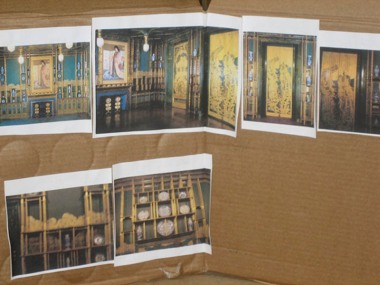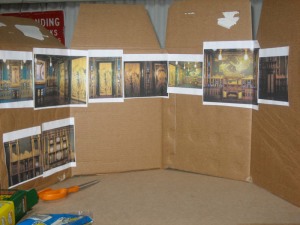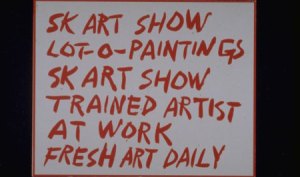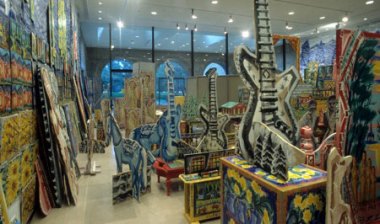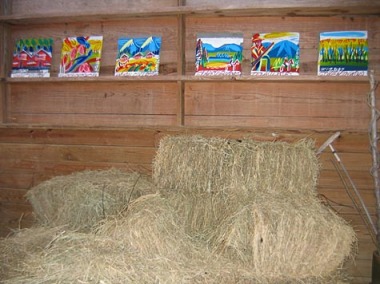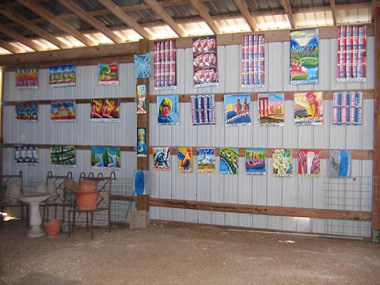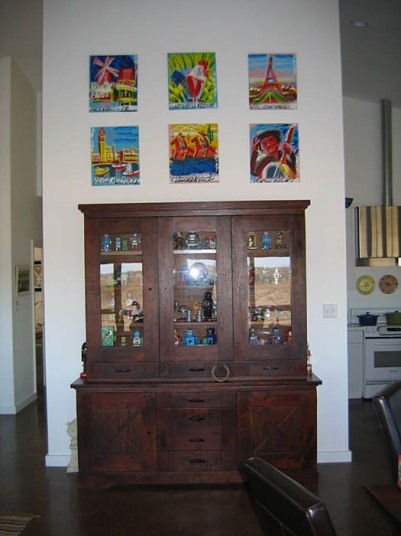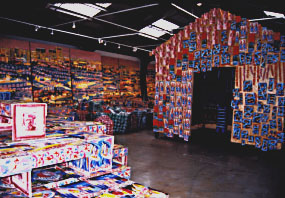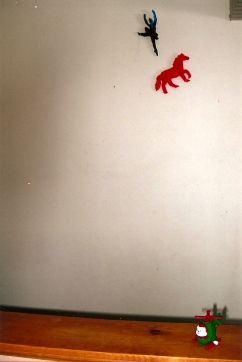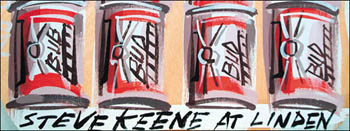The following conversation between Steve Keene and Clinton Krute took place at Steve’s studio/house/store in mid-December of 2007. There are further installments in the works but as with all things, these things take time. For now enjoy this lengthy, rambling interview with Steve, conducted as he industriously wired and prepared plywood boards for future paintings. It ended when Steve’s father-in-law came by to drop off some Christmas presents…
Clinton Krute: You’ve mentioned that you think of your work as musical performance. Do you listen to music as you paint?
Steve Keene: No, mostly stuff like NPR. Because if you’re an artist and you do this every single day, you’re alone all of the time, so you need to actually hear people. I’m here alone, except for the kids in the afternoon, every day, and if you’re a professional artist, and this is your job, you have to get used to that kind of isolation sometimes.
CK: Would you say that your art is not directly inspired by listening to music, but more conceptually inspired?
SK: It’s a reaction to performances. When I’m here working in my studio, it’s kind of trying to figure out a way to beat the loneliness. So talking voices, chatter, is what works the best for me because, basically, I’m in an isolation tank.
CK: Do you find yourself paying attention to what the radio is saying, or are you in the “zone?”
SK: Nah, it’s more kind of just like white noise. I just like to hear the voices talking.
CK: Last time we spoke you mentioned that you think of painting as an athletic endeavor. Could you talk about that idea a little more?
SK: It’s definitely an endurance test, especially the last month because of getting orders out for Christmas. Today is Dec. 18th and I’ve still got to get out about twenty orders next week. I think if I get them out tomorrow, they’ll still be able to get there by Christmas Eve. But I’ve gotten, I guess, a couple of hundred orders out in the past month, which is about three time the regular amount. I get about three orders a day most of the year. Sometimes I get about two orders a day, like in February, when nobody wants anything, but this time of year, I get five, six orders a day for a straight month, all from the website.
CK: Do you sell a lot at the store too?
SK: I don’t sell much at the store. It’s more kind of a pilgrimage site. In a way, the store’s for me. I think of it as a work of art in itself, to make something that’s not torn down in a month. Except, the plus and minus news is that I’m actually closing down the store at the end of the month and moving it here [to the studio] at the end of month, because I’m not paying rent in January. It’ll save me some money that will be used for new equipment that I want to buy. I’ve really fallen in love with woodcutting, which is not really what I’m known for. I’m known for making the 200,000 paintings, which I’m really proud of, but in the process, I’ve really gotten into woodcutting. I don’t know if I really have an audience for that yet, but it’s something that really turns me on, and I’ll see where it goes.
CK: Yeah, the cutout horses and the signs and stuff are great.
SK: Yeah, to make the cutout things was a hobby for me, because the paintings are my day job. I wanted to make something that was the opposite of my paintings, something that was more anonymous. I used to think my paintings were anonymous, but now I’m sort of known for them.
CK: Can you talk about the way in which you felt your paintings were anonymous?
SK: When I first started doing this fifteen years ago, I would just show up with a bunch of paintings of trees or houses or birds or lakes. Like yard sale paintings. It felt like I was just painting something you’d find at a yard sale. Then the whole process became very personal to me and it became my “thing,” what I’m known for. So now I’m into the idea of creating a second body of work that can exist separately on its own and that’s what the wood cut stuff is.
CK: You’re also making these prints of beer cans and roosters I’ve seen at the store. Are those part of this second body of work?
SK: The silk screens, right. That’s just kind of a fun kind of experiment. They’re drawn from the computer, which I enjoy working with. To do anything besides painting is an interesting kind of vacation. When I first started doing this, I was sort of lost in a trance. I was purely unconscious of what I what I was doing. It was just the passion of doing this non-stop and now, for better or for worse, I’ve had fifteen years of doing it, so I’m able to literally look at what I’ve done instead of be in the moment of doing it.
CK: It’s no longer just a physical act, making the paintings.
SK: I’m no longer just lost in a trance. I’m so conscious of what I have done now – I can see what I’ve done in the past fifteen years. When your beginning something, there’s no five minutes ago or five minutes from now. It’s like your right in that moment.
CK: How did you begin using words and phrases in your paintings? They’re often completely unrelated to the image.
SK: It’s like songs or band names. What’s more fun than sitting around for two hours thinking up band names? “I’m gonna name my band ‘The Purple Sidewalk,’ or something.” It’s like a game, and I like the fact that if you add words to the painting, you look at the painting and you read the words at the same time and so for the initial half second that you’re looking at my painting, you’re not caught up with how badly the picture’s painted. You’re kind of caught up in trying to figure out the meaning to it. Normally when you look at art you think, “that painting sucks,” or “that painting’s really good,” but this, if I turn it into instructions or a poem or something like that, you simultaneously read the image and the words. It’s a visual and conceptual thing at the same time. I just think that it becomes a fun game.
CK: It adds a level of mystery to the paintings. You try to connect the words with the image and it adds another level of meaning.
SK: Sometimes people get way too into it and ask me, “Why did you write these words?” And sometimes they do have meaning, you know, but I don’t really talk about it. But most of the time they don’t really.
CK: Do you pick up words and phrases from magazines or whatever might be at hand?
SK: Yeah, the radio or from newspapers that I’m wiping my brushes with. I’ll pick out a phrase or something.
CK: I recently saw some paintings of yours hanging in a bar in Manhattan, one with a T.S. Eliot quote along the base. They seemed to me to be more carefully crafted than most of your work. When and how do you decide to make work that steps outside of the “mass production” model?
SK: It’s purely arbitrary. Those paintings were for somebody specifically. I try not to think about painting. You’re damned if you do, you’re damned if you don’t.
CK: The Nike philosophy of painting?
SK: I guess so, yeah. I don’t even think that what I do is painting. It’s just cranking out a product. I try to get away with doing the least because I’ve worked on pictures that I’ve worked on really carefully, the drawing is done really well, the painting is really structurally sound, and it just seems like, “eh, it’s good, it’s okay.” And then some pictures are almost falling apart, but the colors and the mistakes add a lot. I don’t really like looking at paintings that I did years ago because there are certain paintings… Like, I’ll go to a friend’s house and see a picture I did ten years go and in my mind I’ll think, “I was so much better a long time ago,” and then I look a newer picture, and it looks muddy and static. I don’t have a love of looking at my art. I love making a product, but it’s meant to be information and it’s meant to be utilitarian and it’s meant for people to find in it what they want to. And if they don’t, you know, they only bought it for three, four, five or ten bucks so if they don’t like it they can just give it to a friend or throw it out. Obviously, I take this work seriously, but it’s a game too.
CK: It’s certainly more than a job though, right? It’s not something you do only to support yourself?
SK: Yeah, it’s not the world’s best job. I started out being almost a spoof of an artist because I never really had much success in a traditional way.
CK: Like gallery shows?
SK: Yeah, where people say, “Oh I love your paintings, sell it for four thousand dollars.” It never really worked out that way. It was more like, “Nobody really likes my pictures so I’ll paint a million of them. Screw you!”
CK: Can you talk about how you first began to make paintings this way?
SK: Well, I was in Charlottesville. I was kind of influenced by my friends, back in the day. We were all working at the radio station, WTJU in Charlottesville, and that’s where I met David Berman and Bob Nastanovich and Stephen Malkmus, all these guys in bands.
CK: Were you painting at the time?
SK: I yeah, I was always painting. I was a painter forever. I went to art school, the whole deal.
CK: So you moved down to Charlottesville after you finished graduate school?
SK: Yeah.
CK: What kind of paintings were you doing then?
SK: The paintings looked identical except I’d just do like one a day instead of a hundred a day (laughter).
CK: So what changed? How did you begin to think about painting in the way you do now?
SK: Music. The music world of being around ten thousand albums, and being at a radio station, it really was beautiful, to be surrounded by so many album covers. And also, the creativity of all these people playing music and being really passionate about the music that they played on the radio. I just didn’t see any of that… I mean we’re talking about me sitting in a small college town in Virginia. I wanted to create that kind of fun out of painting a picture and selling a picture and displaying a picture. The guys who were making music were having fun, it was exciting to see them make music and play music and talk about it. Like in art school, art was so boring compared to that. Why can’t art seem fun, like a rock band?
CK: What music were you listening too back then?
SK: My whole thing was everything. I was older than people at the station, and I just played, basically, grunge music. You know, the first grunge.
CK: Like Mudhoney?
SK: No, no, that’s the second grunge. I’m talking about like Mountain and Moby Grape, and just old music from the seventies. It was fun to play the Mudhoney and Green River and the Nirvana with it, and then the next year, that stuff was the biggest thing in the world. It was fun because I felt like I was at the radio station and we’d get these Nirvana records and you’d say, “Oh, this is a cool looking band,” and then literally one year later, they were the biggest band in the world. And we were all at the station at the time. Well not we, I was at the station, and my friends had all moved to New York and were becoming huge themselves. The feeling was, a real kind of deep feeling, that our little radio station was affecting the world.
CK: One connection I see between the music of your friends and your artwork is the exuberance and improvisational aspect that comes across in the home-recorded songs of Pavement and the Silver Jews, who just tossed out improvised pop songs off the top of their heads.
SK: Yeah, I think about that a lot, the paintings and their music. The whole concept behind those guys was that its better to fail dramatically than to just be competent. In some ways, what I do now is I make a product, people know what they’re going to get from me. I don’t really experiment anymore. I make something on a daily basis, like a baker, and so I look at it differently than I did fifteen years ago. Now I’m proud that I’ve created this bakery, but I’m not really experimental in my ideas on a daily basis.


CK: Originally you felt that your art was confrontational and subversive, right?
SK: Yeah, because everybody was like, “Why do you sell your paintings for five dollars? Aren’t paintings supposed to be two hundred dollars or a thousand dollars?” And that’s the only thing anybody ever talked about. People don’t talk about that as much anymore because I’m making a living, so I must know what I’m doing.
CK: Do you feel that because you sell your paintings for so little, that you haven’t been taken as seriously by the art world as you would have been had you made some giant paintings that cost thousands of dollars?
SK: Um, I don’t know what to say about that.
CK: Is it not something you’ve ever considered, going the art world route?
SK: No, I consider it constantly, I just don’t know what to say about it (laughter). I think of stuff like that all the time, but I don’t have any answers.
CK: Well, what traditionally “art world” artists do you feel a kinship with?
SK: My art grew out of German art from the sixties and seventies and eighties: Gerhard Richter and Keifer and Franz West. People who were conceptual and loved to paint, at the same time. That’s not really an American trait. American art is cooler in some ways. American art from the eighties anyway. German art from the eighties is fantastic.
CK: Paintings like Richter’s are often thought of as impersonal, even if he’s painting a picture of his daughter, the technical mastery depersonalizes the painting.
SK: Yeah, when you say impersonal, that’s what I’m doing with my pictures. I have no personal relationship with my pictures because I paint a hundred in a day. It’s a distancing. I have a personal relationship to the experience but not to the work of art.
CK: So you get satisfaction more from the process of making art than from the finished product?
SK: I want both. I want satisfaction from both, but it doesn’t seem to work out that way. Happy birthday!! (Steve’s father-in-law pops in bearing x-mas gifts).
